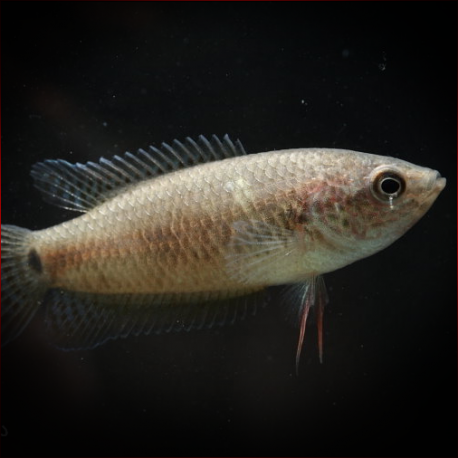More info
Datasheet
| Minimum Tank Size | 60 litres / 15.85 US gallons |
| Maximum Size | 6.5cm / 2.56inches |
| Temperature | 20°C / 68.00°F - 28°C / 82.40°F |
| Hardness | 2.02dgH / 36ppm - 25.04dgH / 447ppm |
| pH | 6.0-7.5 |
General Description
The Spiketail Paradisefish (Pseudosphromenus Cupanus) is distinguishable from its relative, P. dayi, by lacking the two dark lateral stripes on the head and body, and shorter caudal-fins in males. Belonging to the Perciformes order, it falls under the Osphronemidae family. Like other labyrinth fishes, it possesses a labyrinth organ allowing it to breathe atmospheric air to some extent.
Aquarium Setup
For a thriving environment, a 60-liter tank is recommended. Decorate with driftwood, roots, and shady spots, omitting substrates for breeders' convenience. Include potential spawning sites like half-coconut shells or upturned clay flower pots. Dim lighting and surface vegetation are preferable, replicating its natural habitat. Opt for gentle filtration systems, such as air-powered sponge units.
Behaviour
The Spiketail Paradisefish is peaceful but may not suit community tanks due to its timid nature and small size. It interacts well with small cyprinids and loaches but is best kept away from similar-shaped fish. It thrives in groups, exhibiting intriguing behavioral dynamics, especially when in pairs or a larger group setting.
Feeding and Diet
In the wild, this species preys on insect larvae. In captivity, offer small live or frozen foods like Daphnia, Artemia, worms, and insects. While they may inspect dried foods, they do not consume them adequately for optimal health. Preparing live insects with fish flakes or vegetables before feeding is suggested.
Reproduction & Dimorphism
Pseudosphromenus Cupanus is a secretive bubble nester, with males building nests under overhangs or in cavities. Mating involves embracing, egg attachment, and male parental care. Males exhibit extended fins, intense colors during courtship, while females darken. Strong lighting helps in sexing, as only females display a visible ovary extension.
Habitat and Distribution
This species prefers stagnant waters, such as rice paddies and weedy ponds, often inhabiting floodplains and lowland regions. While it is believed to have a broad Southern Asian distribution, the Spiketail Paradisefish is restricted to southern India and Sri Lanka, specifically found in the Sankaraparani River in Tamil Nadu, India.

